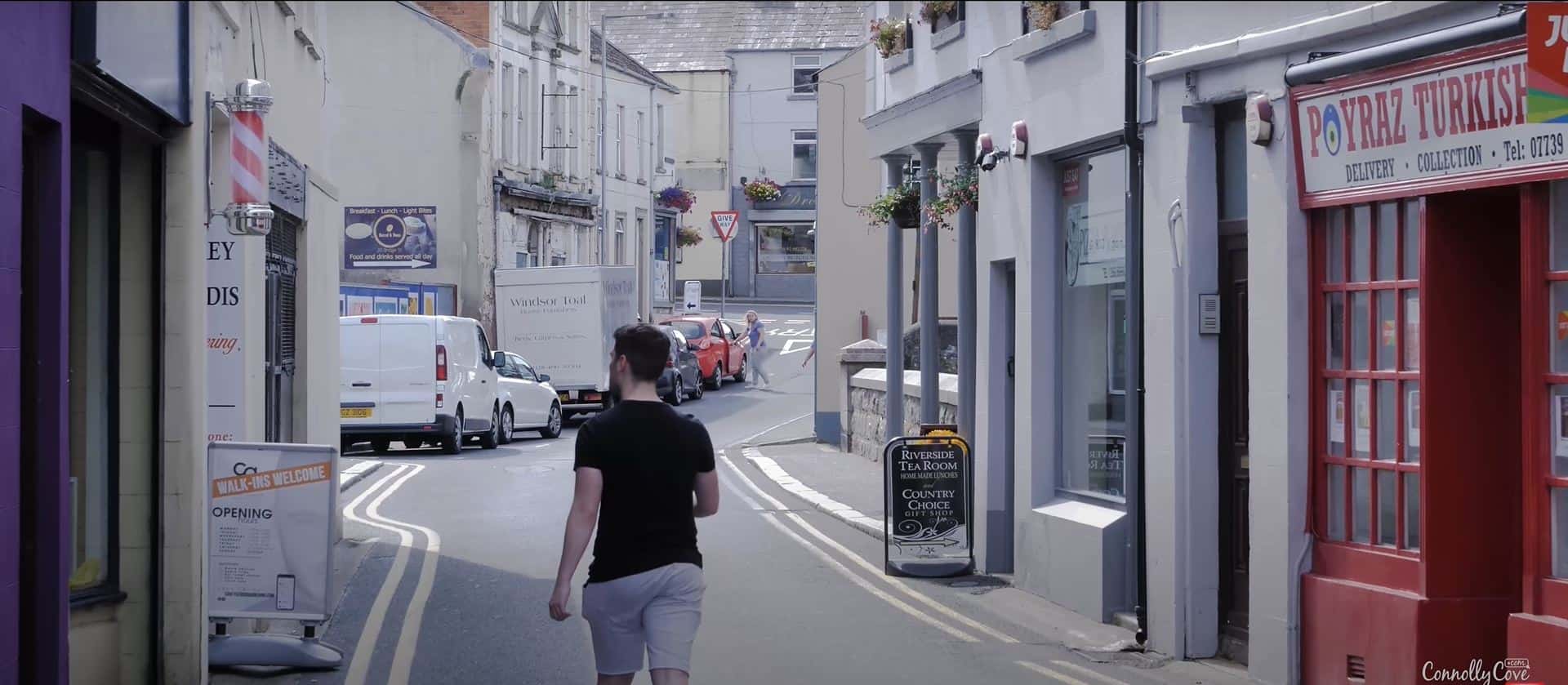Dromore Town | Dromore Cathedral | Dromore Motte and Bailey | County Down, Northern Ireland

Updated On: April 18, 2024 by Maha Yassin
In the picturesque landscapes of County Down, Northern Ireland, a town whispers stories of centuries past and beckons travellers to explore its historical riches. Dromore, with its Gaelic name ‘Druim Mór,’ meaning ‘great ridge,’ is where time seems to have stood still, allowing visitors to step back in history while surrounded by breathtaking natural beauty. This article is an invitation to uncover the hidden treasures of the town, from the grandeur of Dromore Cathedral to the echoes of medieval warfare at Dromore Motte and Bailey. Join us as we embark on a journey through the annals of time and delve into the unique charm of Dromore Town in County Down, Northern Ireland.
Table of Contents
County Down: Nature’s Masterpiece
County Down, situated in the northeastern part of the island of Ireland, is a province renowned for its unparalleled natural beauty. This enchanting region captivates the hearts of all who set foot upon its verdant landscapes. From the majestic Mourne Mountains, which seem to touch the sky, to the tranquil shores of Strangford Lough, County Down boasts diverse environments waiting to be explored. With its rugged coastlines, rolling hills, and lush valleys, this corner of Northern Ireland offers breathtaking scenery and a rich tapestry of history and culture. Whether you’re an intrepid hiker, a history enthusiast, or simply seeking a peaceful escape, County Down welcomes you with open arms, inviting you to discover its many wonders.
Dromore Town: Unlocking the Secrets of Time
It is a town with a history dating back over a thousand years. This historic settlement has evolved over the centuries, retaining its unique character while embracing the modern world.
Historical Significance: Its history can be traced back to the 6th century when Saint Colman founded a monastery here. The town grew around this monastic community, and it became a hub of religious and cultural activity during the early medieval period. Over the centuries, it played a significant role in the region’s history, with its strategic location contributing to its importance.
Medieval Dromore: The medieval era left a lasting imprint on the town, evident in the town’s layout and architecture. Its streets wind their way through the town, revealing historic buildings dating back to the 17th and 18th centuries. As you wander the town, you’ll encounter charming cottages, traditional pubs, and quaint shops, creating an atmosphere that harks back to a bygone era.
Dromore Cathedral: A Testament to Faith and Architecture
One of the town’s most prominent landmarks is Dromore Cathedral, also known as the Cathedral Church of Christ the Redeemer. This beautiful place of worship is a testament to faith and architecture.
History of Dromore Cathedral: It dates back to the early 17th century when it was initially built as a parish church. In 1661, following the restoration of King Charles II to the throne, it was elevated to the status of a cathedral. Since then, it has played a central role in the religious life of Dromore and the wider County Down community.
Architectural Marvel: The cathedral’s architecture blends different styles, including Gothic and Georgian influences. The stunning spire and the intricate stained glass windows are particularly noteworthy. The interior is equally impressive, featuring beautiful woodwork, a magnificent organ, and a serene atmosphere that encourages contemplation and reflection.
Visiting Dromore Cathedral: Whether you’re a history enthusiast, an architecture aficionado, or simply seeking tranquillity, Dromore Cathedral is a must-visit destination. Visitors are welcome to explore the cathedral’s interior, attend services, and enjoy the peaceful surroundings of its churchyard.
Dromore Motte and Bailey: A Glimpse into Medieval Warfare
Just a short distance from Dromore Cathedral lies another historical gem – the Dromore Motte and Bailey. This ancient fortification offers a fascinating glimpse into medieval life and warfare.
Motte and Bailey Basics: A motte and bailey is a medieval fortification of two main elements. The “motte” is a raised earthwork mound, often topped with a wooden or stone tower, while the “bailey” is a courtyard or enclosure situated at the base of the motte. These structures were common across Europe during the Middle Ages and served various purposes, including defence and as centres of administration.
History of Dromore Motte and Bailey: Dromore Motte and Bailey are believed to have been constructed in the 12th century during Norman expansion in Ireland. It would have been an important defensive structure during its time, protecting the town and its inhabitants from potential threats.
Visiting the Site: Today, visitors can explore the remnants of the motte and bailey, which offer a glimpse into the strategic importance of the town in the medieval period. While the wooden tower is long gone, the earthwork mound and bailey remain, providing a sense of what life might have been like within these walls.
County Down’s Natural Beauty Surrounds Dromore
Beyond its historical and architectural treasures, the town is also blessed with a picturesque natural setting. The town is surrounded by the lush landscapes of County Down, making it an ideal base for exploring the region’s beauty.
Lagan Valley Regional Park: The town is situated on the banks of the River Lagan, and the Lagan Valley Regional Park offers an opportunity to immerse yourself in nature. The park boasts scenic walking and cycling trails, picnicking spots, and opportunities for bird watching and fishing.
Slieve Croob: For those seeking a more challenging adventure, Slieve Croob, part of the majestic Mourne Mountains, is within easy reach. Hiking to the summit provides breathtaking panoramic views of the surrounding countryside.
Exploring the Mournes: Dromore’s location makes it an excellent starting point for exploring the Mourne Mountains, an Area of Outstanding Natural Beauty. These rugged peaks and tranquil valleys are a paradise for hikers, photographers, and nature enthusiasts.
Additional Attractions Near Dromore Town
While Dromore Town offers a treasure trove of history and natural beauty, the surrounding area boasts even more attractions that are well worth visiting. Here are some additional places to explore:
- Hillsborough Castle and Gardens: Just a short drive from Dromore, Hillsborough Castle is the Royal Family’s official residence in Northern Ireland. Visitors can tour the elegant Georgian mansion and wander through the beautifully landscaped gardens. The castle often hosts art exhibitions and cultural events, making it a regional cultural hub.
- Castlewellan Forest Park: Located southeast of the town, Castlewellan Forest Park is a haven for outdoor enthusiasts. The park offers numerous walking and cycling trails, a picturesque lake, and a stunning arboretum. The Peace Maze, a challenging hedge maze, is a family highlight.
- Rowallane Garden: This enchanting National Trust property is a short drive east of Dromore. Rowallane Garden is a beautifully landscaped garden featuring various rare and exotic plants. It’s a peaceful place to explore and enjoy the tranquillity of nature.
- Tollymore Forest Park: Located north of the town, Tollymore Forest Park is a must-visit for fans of the hit series “Game of Thrones.” Several scenes were filmed here, and visitors can explore the ancient woodlands, the Shimna River, and picturesque stone bridges.
- Lough Neagh: The largest freshwater lake in the British Isles, Lough Neagh, lies west of the town. It offers opportunities for fishing, boating, and bird-watching. Scenic drives along the shoreline allow visitors to enjoy the breathtaking views.
- Ulster Folk and Transport Museum: Located in Cultra, a short drive north of Dromore, this museum provides a fascinating glimpse into Northern Ireland’s past. It features recreated historic buildings and exhibits showcasing the region’s transportation history, from horse-drawn carriages to steam locomotives.
- Mount Stewart: A bit farther east along the coast, Mount Stewart is another National Trust property known for its magnificent gardens and grand house. The gardens at Mount Stewart are renowned for their colourful displays and unique design.
- Downpatrick: A historic town to the east of Dromore, Downpatrick is steeped in Irish history and is the reputed burial place of Saint Patrick, Ireland’s patron saint. Visitors can explore the Saint Patrick Centre and the Down Cathedral, which houses a stunning Celtic cross.
- Exploring the Mourne Coastal Route: Dromore is an excellent starting point for embarking on the scenic Mourne Coastal Route. This driving route takes you along the stunning coastline, passing charming villages, sandy beaches, and the majestic Mourne Mountains.
These additional attractions near Dromore Town provide ample opportunities for exploration, ensuring that visitors can experience the diverse and captivating beauty of County Down and Northern Ireland.
Conclusion
Dromore, a town with a history of over a millennium, offers visitors a unique blend of historical charm and natural beauty. From the medieval remnants of Dromore Motte and Bailey to the architectural splendour of Dromore Cathedral, there is much to discover in this enchanting town. Moreover, the surrounding landscapes of County Down, including the River Lagan and the Mourne Mountains, provide ample opportunities for outdoor adventure and appreciation of Northern Ireland’s natural wonders.
Whether you’re a history buff, an architecture enthusiast, or a lover of the great outdoors, the town has something to offer. So, when planning your next trip to Northern Ireland, include this hidden gem in your itinerary for an unforgettable journey through time and nature.






